- What is Conversion Rate in Marketing ? Definition, Calculation, and Key differences
- Differences and similarities between conversion rate, email conversion rate, and transformation rate
- Why track your email conversion rate?
- Examples of conversion rates according to your objectives
- What tools can be used to measure your marketing conversion rate?
- What tools are available to measure your email conversion rate?
- 5 tips to improve your email conversion rate optimization
- Let’s recap on email conversion rates.
- Frequently asked questions about email conversion rates
When it comes to calculations, we often see everyone running away… 😅 However, email conversion rates are not complicated!
It shows you whether your campaigns are really effective 💥 or whether your messages are falling by the wayside 📭.
Understanding it is the key to improving your results and turning your emails into real performance drivers.
Ready to boost your conversions? 🚀 Let’s go!
What is Conversion Rate in Marketing ? Definition, Calculation, and Key differences
What is conversion rate optimization ? The conversion rate is simply the percentage of people who take action after receiving your message. 🎯
Whether it’s buying, signing up, downloading, clicking, or whatever your goal may be, this rate shows you whether your marketing strategy is really working. But how to find conversion rate ? Let’s see that ! 👀
How to Calculate Conversion Rate ?
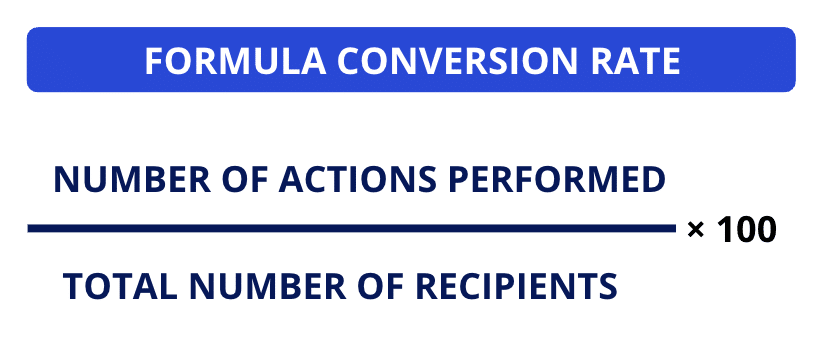
But be careful, there are several variations 👇
- Overall conversion rate: This measures the actions taken across your entire site (purchases, forms, etc.). 🌏
- Email conversion rate: This measures actions resulting directly from your email campaigns. 💌
- Transformation rate: Often used as a synonym, but it also applies to sales or leads generated. 🦸🏻♂️
Example: If you send 1,000 emails and 50 people click on your offer, your conversion rate is 5%.
Differences and similarities between conversion rate, email conversion rate, and transformation rate
These three terms are often used interchangeably, but they don’t mean quite the same thing. 😉 So let’s take a look at them to avoid any confusion and understand how each one applies to your marketing strategy.
| Indicator | Definition | Measured objective | Where to use it | Calculation formula | Good rate (average) |
|---|---|---|---|---|---|
| Conversion rate | Percentage of visitors who perform a desired action on your site (purchase, click, registration, etc.). | Measure the overall effectiveness of a site. | Website, landing page, advertising. | Conversion rate formula: (Number of actions ÷ Total number of visitors) × 100 | 2 to 5% depending on the sector. |
| Email conversion rate | Percentage of email recipients who take action after opening or clicking. | Evaluate the performance of your marketing emails (clicks, purchases, sign-ups, etc.). | Email, newsletters, automated sequences. | how to calculate email conversion rate ? (Actions after clicking ÷ Number of emails sent) × 100 | The conversion rate of email marketing is 1 to 3% in B2C / 3 to 5% in B2B. |
| Conversion rate | Percentage of prospects converted into actual customers after interaction or visit. | Measure sales conversion (lead/customer). | E-commerce, CRM, B2B sales funnel. | Calculation of conversion rate: (Number of customers ÷ Number of prospects) × 100 | 5 to 15% depending on the sector. |
Why track your email conversion rate?
Tracking your email marketing conversion rate is a bit like checking your car’s dashboard before hitting the road. 🚗💨
Without it, it’s hard to know if everything is running smoothly… or if something is wrong.
This figure clearly shows you whether your email efforts are achieving their goal: attracting, convincing, and prompting your readers to take action. By monitoring it, you can:
- 🧭 Measure the effectiveness and identify the ones that perform best.
- 💰 Optimize your return on investment by focusing your efforts on what really converts.
- 🎯 Identify obstacles: an email that doesn’t get clicked, a poorly placed call-to-action, a message that isn’t clear enough, etc.
- 🔁 Continuously improve your future projects by making decisions based on real data.
The conversion rate optimisation guides you toward greater impact, more customers… and less guesswork. 🎲
Examples of conversion rates according to your objectives
Not all conversion rates tell the same story. Between a click, a registration, or a sale, results can vary greatly. 🔄 Here are the most useful benchmarks for gauging your performance. 👇
Email campaigns
This is often the first point of contact with your prospects. Your email conversion rate indicates how many people took the desired action after opening your message, clicking, buying, registering, downloading, etc. 😎
Average Email Conversion Rate :
Click-through rate: 2 to 5% (up to 10% for good customer segmentation)
Email/customer conversion rate: between 1 and 3% in B2C, and 3 to 5% in B2B, depending on the quality of targeting and content.
A clear, personalized, and visually appealing email results in more opens, more clicks, and more sales.
Online sales
The classic question: how many visitors actually make a purchase? 🛒 The e-commerce conversion rate depends on the sector, the price, and the user experience.
📈 In general:
- 1 to 3%: Average,
- 3 to 5%: Good result,
- +5%: Excellent site or irresistible offer. 💥
👉 The best online stores (smooth UI/UX, clear offers, social proof) can reach 7 to 8%, or even more.
Subscription rate
Newsletter, free trial, premium service… here, we mainly measure your ability to create a real relationship with your visitors 🤝. The conversion rate reflects the perceived value of your offer: the more useful, clear, and accessible it seems, the more people will sign up.
In general, a rate between 10 and 20% is already a very good sign. Above 25%, you have something solid: your promise is well formulated and your subscription process is smooth.
And remember, the more specific your message is, such as “Receive 1 exclusive tip every week” the more appealing it is. People like to know exactly what they’re getting when they click.✨
Download rate
Guides, white papers, templates… anything that can be downloaded is a lever for acquisition. The rate depends on the relevance of the content and the ease of use of the form.
📚 Benchmarks:
– 5 to 10%: Fair.
– 10 to 30%: Very good.
– +30%: Excellent content with high perceived value.
👀 If your visitors immediately see what they stand to gain, they will click without hesitation.
Ad click-through rates
Here, we measure curiosity, or rather, the real impact of your message. 😏 The ad conversion rate is the proportion of people who clicked on your ad after seeing it.
On average, a rate between 1 and 3% is considered normal. Once you exceed 4 to 5%, the communication really starts to perform well. And beyond that, it’s often a sign that your message is hitting the mark 🎯.
Results vary greatly depending on the platform: an effective ad on LinkedIn will not necessarily yield the same results on TikTok or Meta. Each network has its own codes, its own audience, and above all… its own way of clicking. 😎
What factors should you consider to improve your conversion rates?
These figures are not fixed; they change with your market, your offers, and your efforts. The key factors are:
- 🏠 The industry.
- 👩🏻💻User experience.
- 💪🏻 The level of competition.
- 📨 Messages, your email and marketing strategies.
- 📋 The quality of your email/customer lists.
The goal is not to have “the best rate in the world”, but to identify areas for improvement and make continuous progress. 📈
What tools can be used to measure your marketing conversion rate?
There are several powerful tools for measuring this KPI and analyzing your website’s performance. Here are a few of them:
- Google Analytics: This is one of the most widely used web analytics tools. It provides detailed information about your site’s traffic, user behavior, traffic sources, and the famous conversion rate marketing. You can also track conversions for specific goals, such as sales, subscription forms, downloads, and more. This tool is free and relatively easy ✅ to integrate into your website.

- Google Tag Manager: Another Google tool that makes it easy to manage tracking tags and Google conversion pixels on your website. It also allows you to easily add and modify tags without having to touch your site’s code, simplifying the tracking of customer conversion rates for different actions.
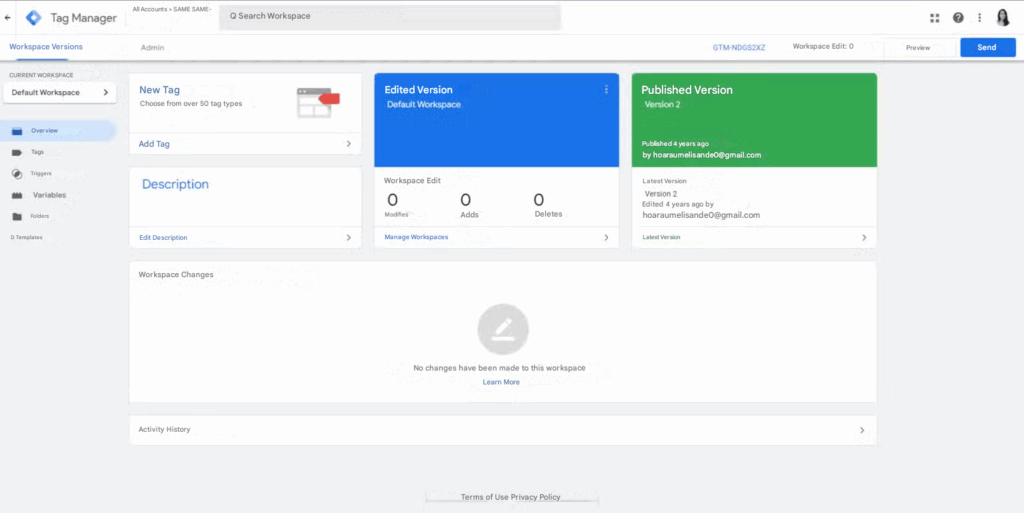
- Hotjar: This is another customer experience analysis tool that offers heat maps, session recordings, and surveys to better understand your visitors’ behavior. It helps you identify your website’s weak points and optimize the customer journey.
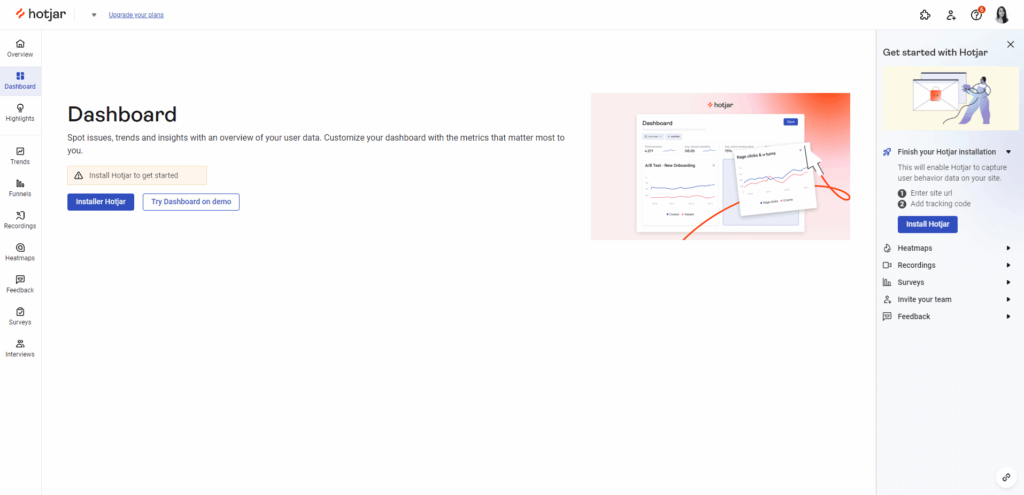
What tools are available to measure your email conversion rate?
To effectively track your email conversion rates, you need tools that can measure much more than just open rates. The goal is to find out which emails generate real actions, clicks, sign-ups, and sales, and to understand why. 🕵🏻
Waalaxy, the tool for understanding your email conversion rate
If you’re looking for a tool that goes way beyond a simple dashboard, Waalaxy is made for you. 🚀
Before you even start tracking your conversion rates, Waalaxy lets you find and automatically import your prospects — from LinkedIn, via an email finder, or from your existing contact lists.
Once your leads are in, you can launch automated email and LinkedIn message sequences, fully personalized based on your prospects’ behavior. 😎
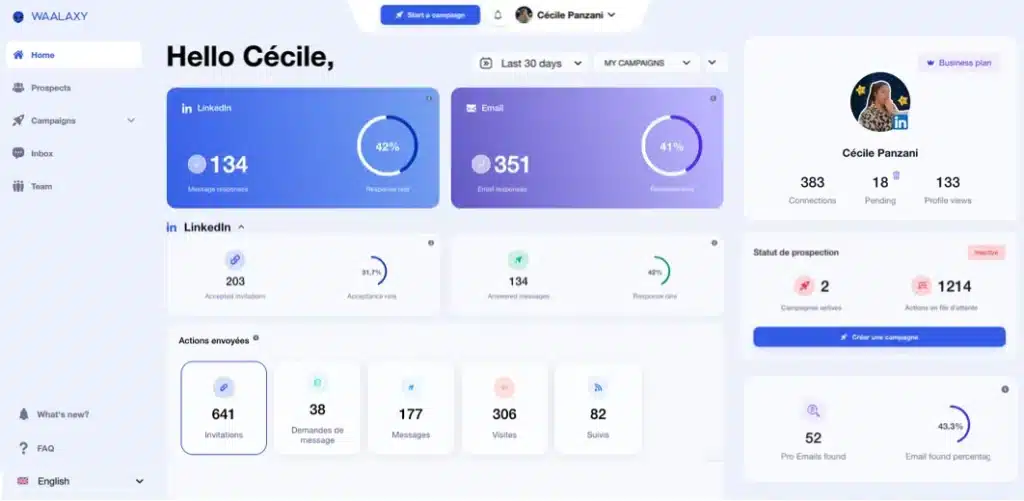
But that’s not all — Waalaxy brings all your marketing actions together in one intuitive platform.
You can track the entire customer journey, from the first touchpoint to the final conversion, and get detailed insights into your open rate, click, and email conversion rates. 📈
Everything is automated, seamless, and visual. You’re not just looking at numbers anymore, you’re understanding your conversions in real time. A must-have for B2B prospecting or multichannel nurturing. ✨
Mailchimp
Mailchimp is the classic choice: reliable, robust, and packed with data. It tracks your clicks, sales, and even the revenue generated by each cold email campaign. It is designed specifically for marketing emails like newsletters. Segment analysis and smart automation allow you to take personalization even further. Ideal for brands that want to dig into data, understand their audiences and email conversion rates, and test without limits. 😉
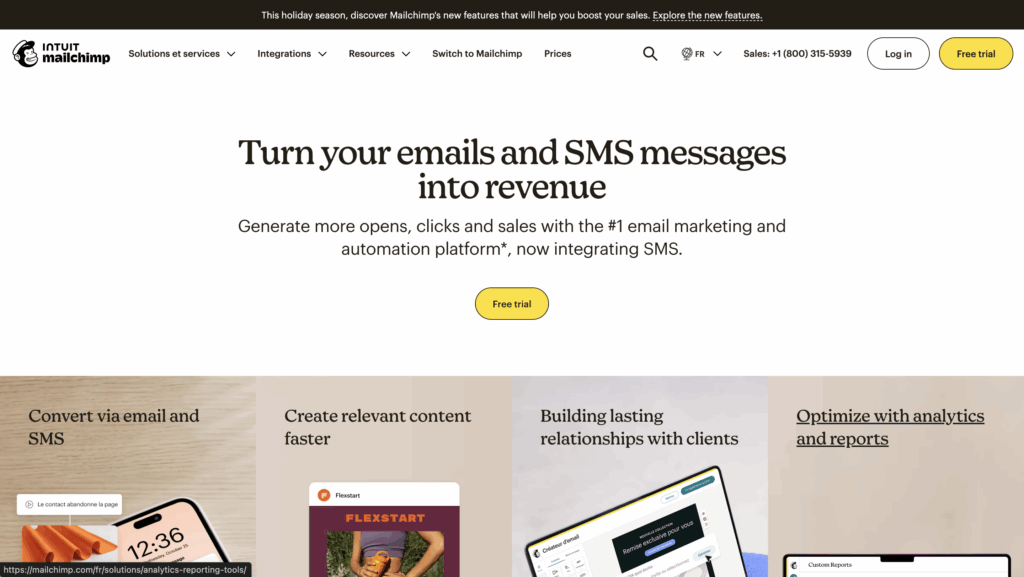
5 tips to improve your email conversion rate optimization
If you want to get your email strategies off the ground ✈️ and boost your email conversion rate, you’ll need to go beyond pretty visuals and a catchy tagline.
1. Know your audience
Before clicking on “or sending”, ask yourself who you are talking to. An email only has an impact if it is addressed to the right person with the right message. That’s why segmentation is the basis of everything. 👀
Use your data to create specific buyer personas : age, job title, needs, motivations, obstacles, communication preferences, etc. A message addressed to “everyone” doesn’t really speak to anyone. 🫠
Example: you won’t talk to a hot prospect who is ready to buy in the same way as you would talk to a new contact who is just discovering your brand.
The more refined your segmentation, the higher your email conversion rate will be.📈
2. Analyze and optimize your emails
To improve your conversions, you need to A/B test, analyze, and adjust relentlessly. Each email send-out gives you key indicators: open rate, click-through rate, unsubscribe rate… and above all, email conversion rate.
➡️ Start by examining:
- Which email subjects get the most opens?
- Which links or CTAs attract the most clicks?
- When do your readers lose interest?
Then take action: test different versions of the same email, vary the visuals, formats, and CTAs.
A simple change in the subject line or button can increase your click-through rate by 20 to 30%. 🎊
And above all, don’t let your emails stagnate. Analyze your results after each mailing to adapt your future strategies. 📊
3. Create persuasive and human content
A good email is not a disguised advertisement: it is a conversation. Your goal is to make people want to take action, not to force their hand. To do this, copywriting is your best ally.
At Waalaxy, we like to create simple and funny messages like this one: 👇
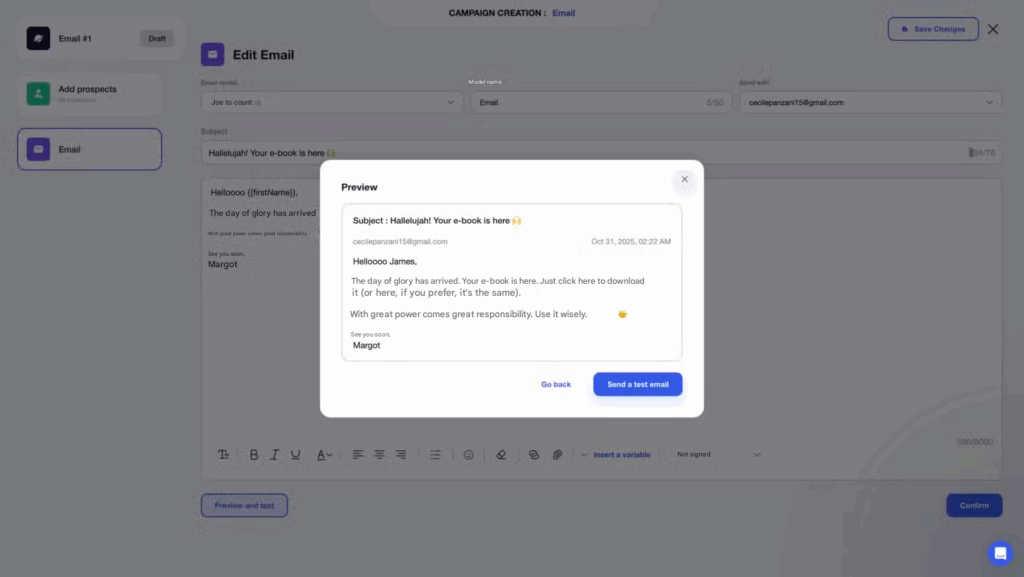
This example illustrates a simple rule: be authentic, clear, and engaging. Stories, emotions, and humor are much more powerful than formatted sentences. 🤖
And if you add to that a few copywriting techniques, a catchy headline, a touch of urgency (“limited offer”), social proof, or a well-placed anecdote, your emails will become irresistible ✨.
4. Craft your calls to action
Your CTA (Call to Action) is the conversion engine of your email. A good CTA not only tells you what to do, it shows you why to do it.
Choose clear and engaging phrases 👇🏻:
- “Discover the offer” > “Click here”
- “Download my free guide” > “Download”
- “Book my demo” > “Sign up”
The CTA should stand out visually, be readable on mobile devices, and appear several times if necessary (at the top, in the middle, at the end). Feel free to test different colors or wording: a simple adjustment can impact your click-through rate and therefore your email conversion rate. 🥳
Above all, ensure consistency between your email and the landing page. If your promise in the subject line is ” “Free Guide”,” don’t link to a page that asks for payment 😉
5. Simplify the conversion journey
Last but not least, make life easier for your readers. 🥹
Every extra step, every unnecessary click, every delay in loading… reduces your chances of conversion.
Make sure that 👇🏻:
- Your emails display perfectly on mobile devices 📱 (more than 60% of opens occur on mobile devices).
- The link or button leads directly to the right page.
- The conversion form is short, fluid, and reassuring (avoid unnecessary fields).
- Your landing page loads quickly and maintains the same tone as the email.
💬The user experience should be as simple as one click per action. Less friction leads to a higher email conversion rate.
Let’s recap on email conversion rates.
The email conversion rate is not just a number: it reflects the effectiveness of your campaigns. 💌
It shows what works, what doesn’t, and most importantly, how to do better.
By understanding your data, testing your messages, and simplifying the reader journey, you can turn your emails into real performance drivers. 🚀
And if you want to go further, Waalaxy helps you track, analyze, and improve every step of the customer journey, from the first click to the final conversion. Smarter emails, more targeted actions… and performance indicators that skyrocket 📈.
Frequently asked questions about email conversion rates
What is a good response rate for email marketing?
The response rate measures the percentage of people who clicked on your email among those who opened it. It is an email marketing KPI that helps you understand the actual engagement of your readers and the relevance of your messages 💌.
On average, a good response rate is between 10% and 20%. But be careful, a good click-through rate does not always mean a good email conversion rate. The latter shows how many recipients performed the desired final action, such as a purchase, registration, download, etc. ☺️
What is the cold email conversion rate ?
The average customer conversion rate for cold email is 1% to 5% . 🤑
What is a good conversion rate?
There is no universal conversion rate, as it all depends on your business, your audience, and your goals. The result may vary depending on the type of website, industry, maturity of your strategy, or even the quality of traffic. 🌐
In general, a good conversion rate is between 2% and 5% for an e-commerce site and can be higher in B2B depending on the level of lead qualification. 👩🏻💻
👉 Not to be confused with the email conversion rate, which measures the performance of your email : how many recipients actually take action after receiving the message (purchase, registration, download, etc.).
Now you know everything there is to know about email conversion rates!









